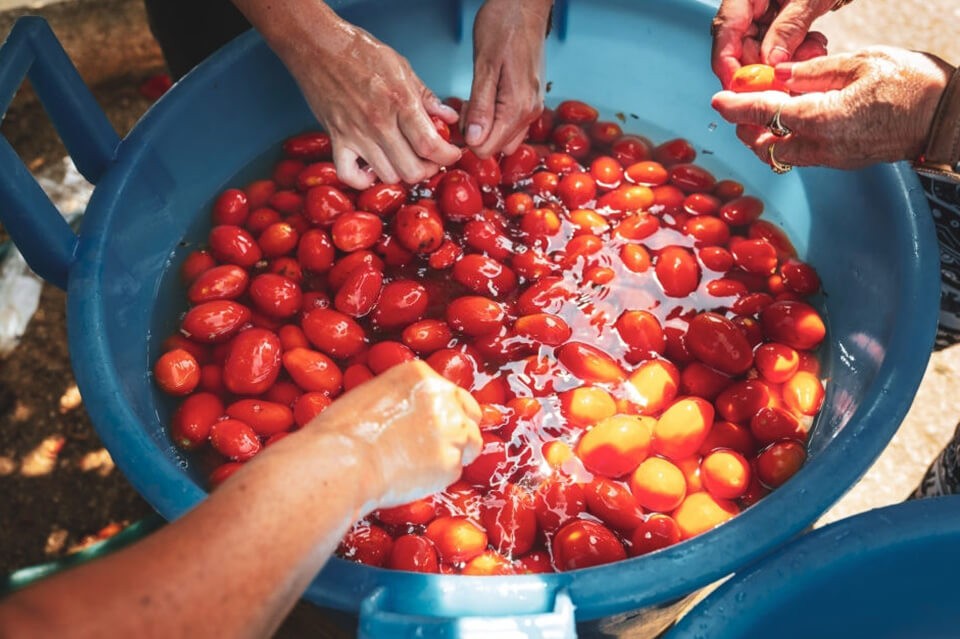Making Tomato Puree: A Summer Ritual Etched in My Memory

Today, I buy tomato puree at the supermarket like most people do. But until about twenty years ago, when I still lived in the countryside, we made it at home. And before that, as a child, I experimented with it at my parents' house, surrounded by my siblings. Sometimes we all made it together, with my aunts and cousins. It was a tradition that marked the height of summer: an exhausting, joyful and unforgettable ritual.
We didn't just make a few bottles. The amount of tomatoes we processed was almost industrial: about 200 kilograms. In our family of seven, tomato puree was a staple, prepared every Sunday. Sometimes it was enriched with meat rolls, sometimes it was plain, but always poured generously over every type of pasta imaginable.

Back then, there were no large outdoor gas burners. We had to light a fire with wood in the garden, and that meant waking up very early – around 4 in the morning – when it was still dark and cool. My mother and I would start the day in silence, working in the dim light before the rest of the family joined us.
A couple of days earlier, the tomatoes had been laid out on the floor in the house for even ripening. On the day of the big harvest, we selected them one by one, discarding the ones that had gone bad. Then came the time to wash them, done in huge zinc tubs, using only our hands and a lot of patience. Once cleaned, the tomatoes were left to drain in wooden crates.

The next step was to crush the tomatoes by hand in large aluminum pots. To the pot we added handfuls of fresh basil, plenty of roughly chopped onions and a generous amount of salt. The mixture was brought to a slow boil on the stove. We stirred constantly with a huge wooden spoon to prevent the bottom from burning.

Once the sauce was fully cooked, while still boiling, it was carefully poured into wooden boxes lined with a fine mesh fabric, similar to tulle. These boxes were slightly tilted so that the excess water could drain naturally. We would let the mixture sit like this for a while, then scoop it out with a large slotted spoon and pour it into bowls.
Then came the hardest part: separating the peels and seeds from the pulp using a manual food mill. Everyone turned the crank in turns – me, my brothers and cousins – and although it was tiring, it always became a bit of a game, a competition to see who could do it the fastest or for the longest time. The pulp that came out was thick, fragrant and hot.
The passata was collected in a large basin and from there we poured it into bottles – mostly recycled wine and beer bottles – using a funnel. These bottles had been used year after year and cleaning them was a real ritual. We filled them with hot water and pebbles, shook them vigorously, and left them upside down in neat rows to dry.

Once filled, each bottle was sealed with a crown cap using a special hand tool. Then came the sterilization process. The bottles were placed horizontally in large metal containers filled with water, carefully separated by strips of old army blankets – beige with a dark Greek key – to prevent them from bumping into each other and breaking during the boiling process.
The containers were placed on the stove and left to boil slowly. We then left the bottles to cool overnight, still in the water. The next morning, they were taken out, dried, and stored in wooden crates in the pantry. Occasionally a bottle would break during the sterilization process: we knew it because the water was red with sauce.
Our homemade passata was so thick that, when it was time to use it, we had to shake the bottle vigorously to get it out. The taste and aroma were unlike anything you'd buy at the supermarket. It didn't even stain tablecloths, unlike today's sauces, which leave marks that are almost impossible to remove.
Making passata was never just about food. It was a way of life, a moment of conviviality, of tradition. It marked the passing of summer, the preservation of flavor and the continuation of family rhythms. It's one of my earliest culinary memories, and one of the most vivid. Even today, the smell of cooked tomatoes and basil is enough to take me back to those morning fires, the zinc tubs and the clinking of glass bottles: the soundscape of a distant but never forgotten summer.
